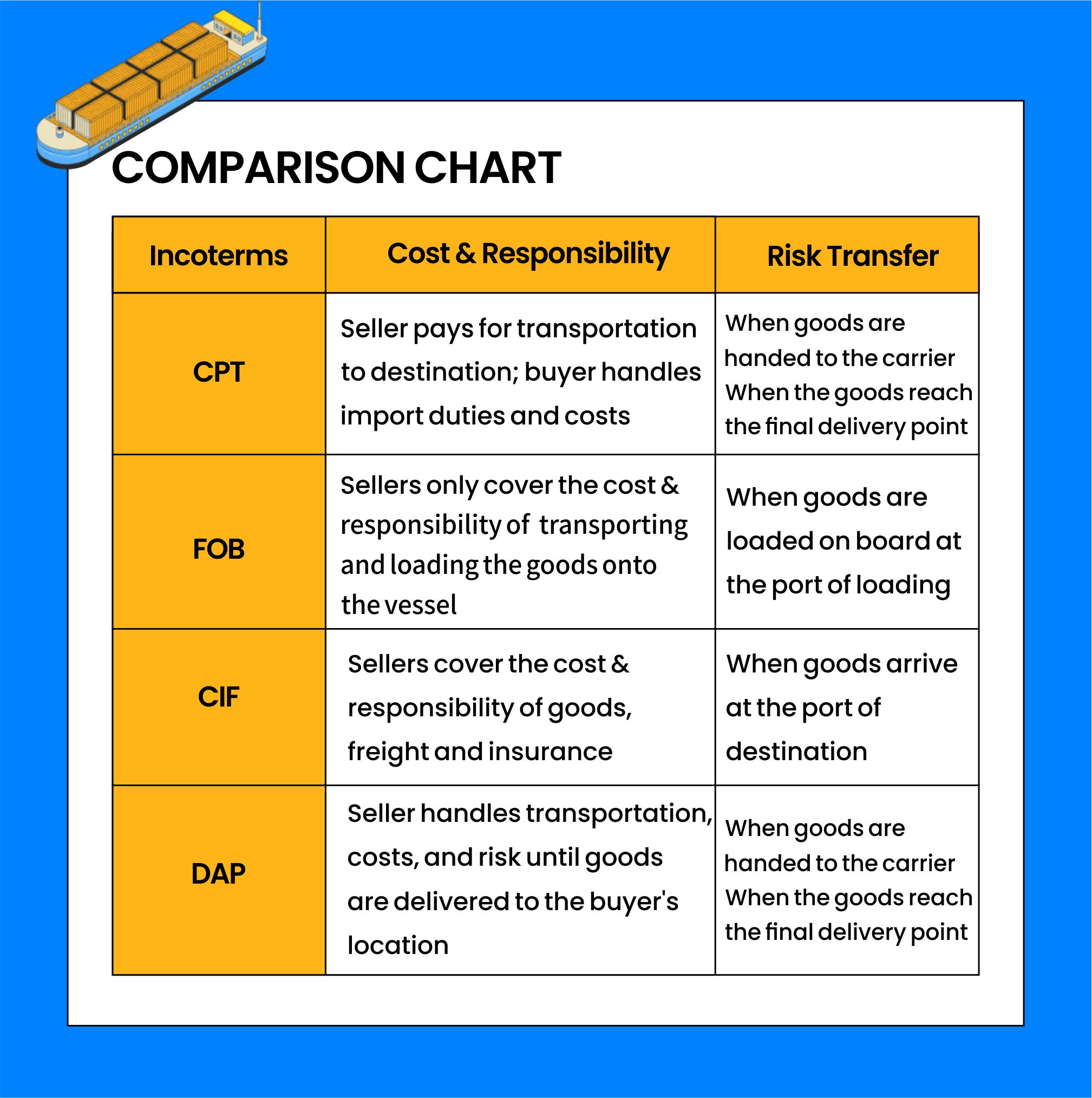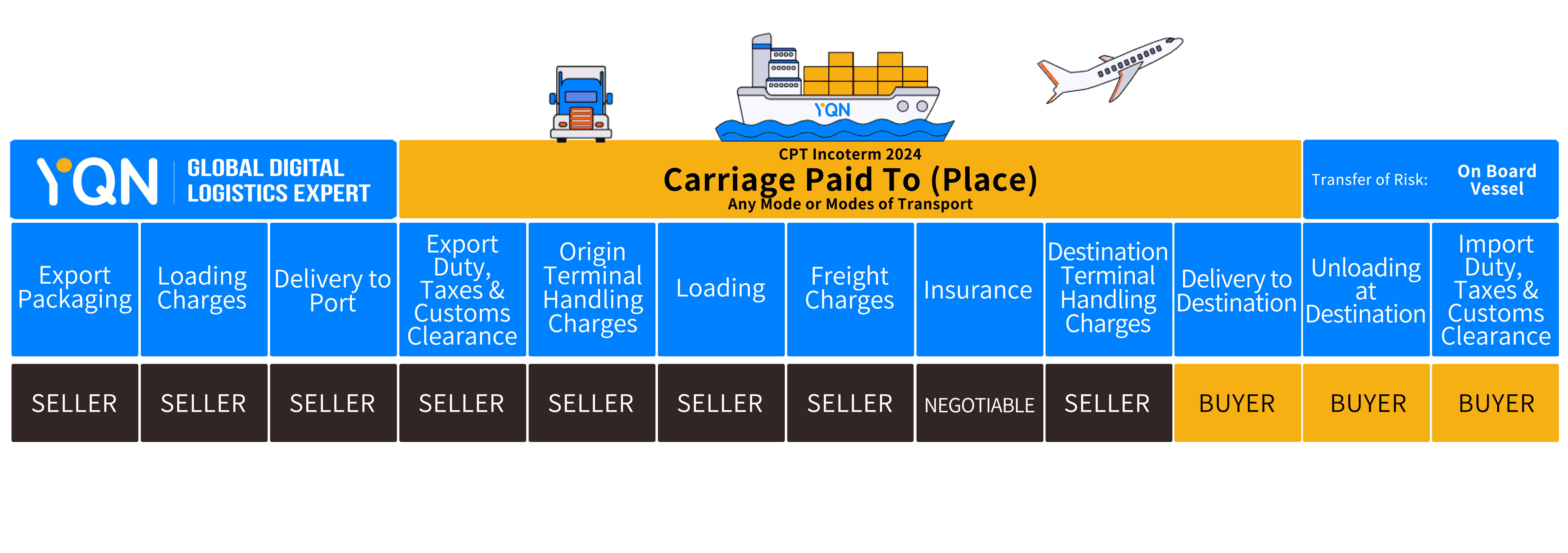CPT Incoterms: Simplifying Your Global Shipping
Sep 30, 2024
Navigating the world of international trade may be difficult, but the Incoterms rules make it easier by setting clear rules and responsibilities for buyers and sellers. Whether you are an experienced exporter or new to trading, understanding how CPT works can save you time, money, and hassle. In this article, YQN Logistics will explain what CPT means, how it works, and why it might be the perfect choice for you.
Table of Contents
1. What does CPT Mean?
2. Key Responsibilities Under CPT
3. When should I Use CPT?
4. Benefits of CPT
5. CPT vs Other Incoterms: Which is Appropriate for You?
6. Key Considerations for Using CPT Incoterms
7. Conclusion: Is CPT the Right Choice for Your Business?
What does CPT Mean?
CPT, short for Carriage Paid To, is an international trade term that defines who is responsible for the cost of transportation and when the risk of the goods passes from the seller to the buyer.
Under CPT Incoterms, the seller bears the cost of transporting the goods to the named destination. However, once the seller hands the goods over to the carrier, the risk of loss/damage passes to the buyer. This makes CPT an attractive option for sellers who want to minimize their risk.
Key Responsibilities Under CPT
Seller's responsibility:
• Transportation Costs: The seller pays the costs of transporting the goods to the agreed destination.
• Export Clearance: The seller is responsible for handling export documentation and customs clearance.
• Delivery to Carrier: The seller delivers the goods to the carrier and the risk passes.
• Shipping Documents: The seller provides proof of shipment, such as a bill of lading or waybill.
Buyer's responsibility:
• Post-shipping risk: Once the goods are handed over to the carrier, the buyer assumes all risk for the goods.
• Import Clearance: The buyer is responsible for handling import duties, taxes, and customs clearance in the destination country.
• Unloading Costs: Unless additional agreed, the buyer pays the unloading costs.
When should You Use CPT?
CPT is ideal when a seller wants to control transportation costs and transfer risk early in the transportation service process. It applies to multiple modes of transportation, including air, sea, rail, or road.
Why choose CPT?
• You want to be in control of your transportation logistics but also want to limit the risk of your shipments once the goods leave your control.
• You ship to multiple destinations and need simple and clear agreements for each transaction.
• You need the flexibility to move goods by different modes of transportation (road, air, sea).
Benefits of CPT
Simple and clear responsibilities: CPT clearly defines who is responsible for transportation and when risk is transferred, reducing confusion and potential disputes.
Early risk transfer: Once the goods are handed over to the carrier, the seller can benefit by transferring the risk of damage/loss to the buyer. This can give you peace of mind, especially for long-distance transportation.
Applicable to multiple modes of transportation: Whether the goods are transported by road, sea, air, or rail, CPT Incoterms are applicable. This versatility is a major advantage for companies dealing with complex logistics.
CPT vs Other Incoterms: Which is Appropriate for You?
CPT vs FOB: Under FOB terms, the seller's responsibility ends once the goods are loaded onto the ship. However, with CPT, the seller remains responsible for costs until the goods reach their destination, but the risk is transferred to the buyer in advance when the goods are handed over to the carrier.
CPT vs CIF: While both terms involve the seller bearing the cost of transportation, CIF requires the seller to provide insurance as well. In contrast, in CPT the buyer arranges the insurance and thus controls the level of coverage.
CPT vs DAP: DAP places more responsibility on the seller, requiring them to ensure that the goods are delivered to the buyer's specific location. In contrast, CPT ends the seller's responsibility after the goods have been handed over to the carrier, which imposes fewer requirements.

Key Considerations for Using CPT Incoterms
Keep the following key points in mind when using CPT in your contracts:
Insurance: Since the risk passes to the buyer early on, the seller does not need to provide insurance under CPT. It's crucial for the buyer to arrange insurance against potential losses.
Documentation: Ensure that the contract clearly defines the point of risk transfer and the role of the carrier. Miscommunication at this stage may lead to major problems later.
Customs and Duties: Be aware of who is responsible for import clearance and associated costs. While the seller pays for transportation, the buyer must handle import duties and taxes under CPT.
Conclusion: Is CPT the Right Choice for Your Business?
CPT may be a smart choice for businesses looking to simplify international shipping while controlling risk. By choosing CPT, sellers can control transportation costs and buyers can manage the risks associated with transportation.
YQN Logistics believes that whether you are new to global trade or a seasoned professional, CPT offers a flexible and reliable solution for your transportation needs.





